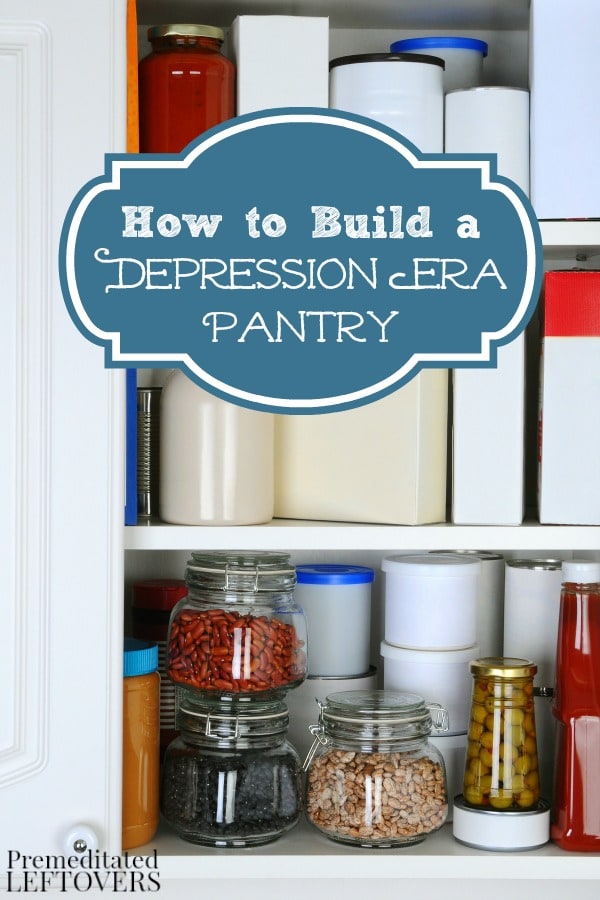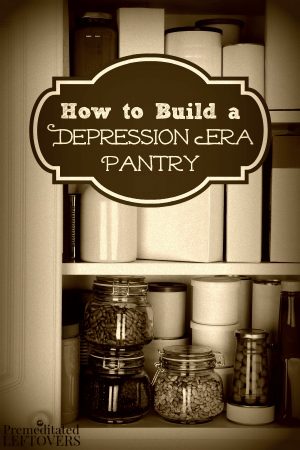Use these tips on how to build a depression-era pantry to help you weather hard times.

A pantry from the depression era might look very different from the one you have in some ways. There were not many pre-packaged foods or quick meals and there wasn’t very much in the way of pre-made snacks for kids, either. However, creating your pantry to look more like one did during the depression era can save you a lot of money and allow you to make a lot of the items you buy now from scratch to save you even more. If you are looking to go back to some old fashioned ways in order to save some cash, here are some tips on How to Build a Depression Era Pantry.
How to Build a Depression Era Pantry
Go back to basics.
Depression-era pantries didn’t have a lot of extras or packaged goods. They relied heavily on foods that could be bought in what we consider bulk today. This meant they bought a lot of ingredients rather than ready-made food. The pantry consisted of flour for making things like bread or using as fillers, honey as a sweetener, salt for seasoning everything, cornmeal for making grits and cornbread and so on. Depending on where you lived often determined what was readily available. These days, you can buy most basics at the bulk areas of certain grocery stores. When deciding what to have on hand, think as whole food as possible and skip pre-made mixes.
Have lots of beans on hand.
Since meat was expensive and many families could not afford to have it every day or every meal as many of us do now, many people relied on beans to act as a source of protein as well as a way to stretch meat further. I do this today when I make soups, casseroles, and skillet meals. Beans are an excellent way to save money in many recipes. You can buy bulk dried beans for far cheaper than canned ones, too. Cooking with dried beans is pretty simple and there are several ways to do it.
Have a lot of seasonings.
Spices are another item most cooks loved to have on hand. Although getting them might have been more of a challenge during the Great Depression than it is today. Because depression era cooking was so basic, it was important to have seasonings to add lots of flavor. Many cooks grew their own herbs in pots and dehydrated them to save for later. Lucky us that we have more options now, although growing herbs indoors or out is still a very simple thing to do as well.
Consider gardening so you are able to can produce for later.
During these desperate times, most families found ways to grow much of their own food in the form of gardening or raising animals if they had space. If you have space to garden on a larger scale, considering growing some foods that you are able to can for later use to add to your stockpile the way that depression-era pantry builders did.
Dehydrate foods.
I have always wanted a dehydrator. Dehydrating foods is a great way to use extra supplies that you have and not let it go to waste as well as create shelf-stable foods. During the depression, many families didn’t have very good ways to refrigerate as refrigerators for home use had just been invented a decade or two earlier and they were often out of many people’s budget. This meant that they had to find ways to keep foods shelf-stable. Dehydrating is a good way to do this as dehydrated foods will last for months.
Depression Era Recipes:
Depression Era Dessert Recipes
Depression Era Breakfast Recipes
Frugal and Filling Depression Era Meals
More Ways to Build a Frugal Pantry:
7 Canning Tips for all Seasons
How to Cut Your Grocery Bill While Eating Real Food
How to Buy Whole Foods on a Limited Budget



Michelle Hurlbut says
I LOVE this post because it assures me that I am already doing things as frugally as I can! Beans have not been our favorite, but I have gradually incorporated them into our meals to stretch meat and meals; I make taco meat with only half the meat and supplement with a can of refried beans and do the same with chili. I’ve even made my own refried beans and pork and beans from scratch! I got a dehydrator a couple yrs ago and like the savings of space storage. Last year I dehydrated eggplant and I use it as a meat supplement and even on pizza. Used to think the only way to eat eggplant was fried, which meant it could only be used fresh. It is almost like tofu! I buy in bulk and can a of my garden produce. Great advice!
Monica says
Wonderful information just TOO MANY ADDS! Would have loved to save your posts.
Deborah says
I cooked a pot of pinto beans earlier this week and added a bit of ground beef and onion to it. A little salt and pepper and cumin. After the beans were done, I added a can of rotel tomatoes and heated them up. We had 2 encore meals and 1 meal the day I cooked it. The other 2 were frozen in meal size packages. Love me some encore meals
Petro Walters says
I recently started watching the BBC series wartime kitchen and I loved it. Not just because I love history, but because the food and preparation fascinates me.
I am literally searching high and low at the moment to find more info on war time cooking. Thank you for this post – it helps a lot. Do you know where else one could find books that were published in that time? PDF would be grand.
Greetings and blessings from Namibia in Africa
Judi says
I love a you tube channel called depression era cooking with Clara. I also got her book and dvd. The book is called Clara’s Kitchen. It’s really a wonderful channel as she is talking with her grandson about the depression with stories. He is the cameraman. I think you might really enjoy her.
Holly W. says
You would love a blog called The 1940’s Experiment. It has a very large WWII recipe collection there. A lovely lady runs it.